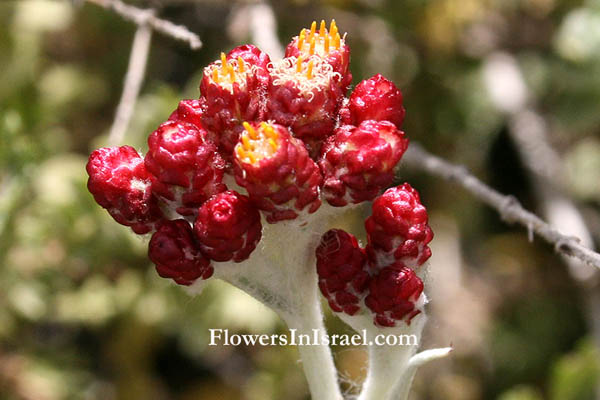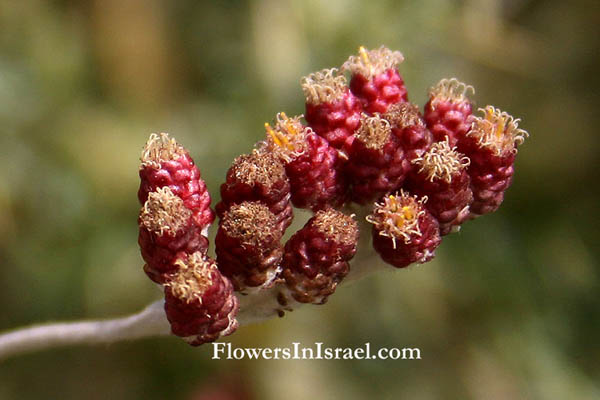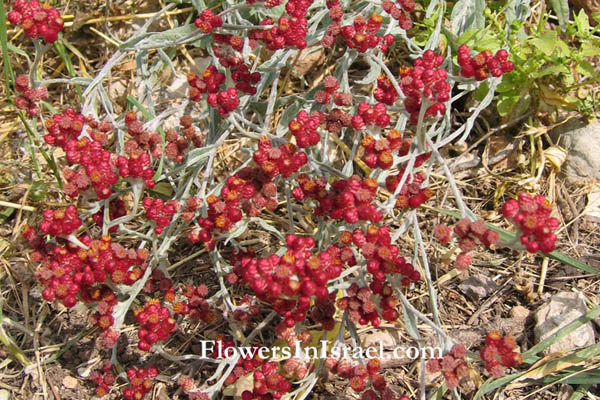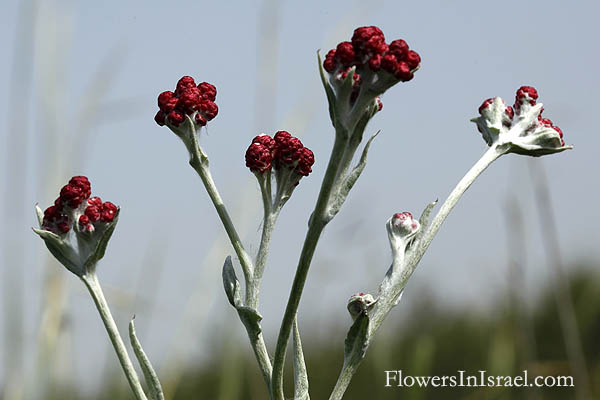Hebrew: דם-מכבים אדום, Arabic: دم المسيح
| Scientific name: | Helichrysum sanguineum (L.) Kostel | |
| Synonym name: | Gnaphalium sanguineum L. | |
| Common name: | Red Everlasting, Red cudweed | |
| Hebrew name: | דם-מכבים אדום | |
| Arabic name: | دم المسيح, dam al-Massiah | |
| Family: | Compositae / Asteraceae, מורכבים |

|
| Life form: | Hemicryptophyte | |
| Stems: | 20-30 cm high; woolly-tomentose | |
| Leaves: | Alternate, rosette, entire | |
| Inflorescence: | Scarious flowerheads; radiated involucres, terminal cluster | |
| Flowers: | Hermaphrodite; red-straw like bracts, cilindrical yellow flowers | |
| Fruits / pods: | Cypselae oblong | |
| Flowering Period: | April, May, June | |
| Habitat: | Batha, Phrygana | |
| Distribution: | Mediterranean Woodlands and Shrublands, Semi-steppe shrublands | |
| Chorotype: | Mediterranean | |
| Summer shedding: | Ephemeral |

Derivation of the botanical name: Helichrysum, Greek helios, the sun; chrysos, golden; referring to the colour of many of the flowers of species in this genus. sanguineum, Latin sanguis, blood; blood-red. Gnaphalium, Greek gnaphalon, "a lock of wool," describing these plants as floccose-woolly.
In Israel Red Everlasting has the same symbolism as in Britain the red poppy, to symbolise the blood of the fallen on Flanders field in World War I, and so became the flower worn on Remembrance Sunday, the Sunday nearest to 11 November. Itzhak Sadeh, ("The old man") (1890-1952) the commander of the Palmach units, a soldier, a writer and an educator, explained to the young Israeli tzabbarim the source of Israeli heroism and the uniqueness of the death of fighters in Israel, as distinct from the death of Jews in other places. The Macabees are described as a symbol of "fighting without fear - for faith, the right to faith, for the homeland, to live free in the homeland, self-defense, to stand in battle and in the end, victory. And their blood, let's say it in all simplicity and confidence, flows in our veins. We are exactly like them. If a drop of our blood falls on the soil of our homeland, a flower will grow… small and red - dam hamakabim (Helichrysum sanguineum). Only in this land, the homeland, does this flower grow amongst the other flowers … dam hamakabim". Many people wear stickers bearing an image of this flower and the Hebrew word nizkor-"We will remember", distributed on Memorial Day in schools and public meetings. On the occasion of the Sixth Independence Day a stamp was issued with the inscription "Yehiam" and on the tab the inscription: ''Independence Day 5714-1954Memorial Day for the Fighters for Independence'' (designer Otte Wallish). "Dam Hamakabim" - blood of the Maccabees is the only helichrysum found in Israel. 

|